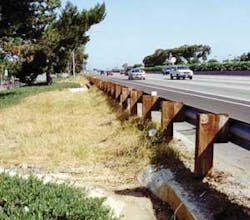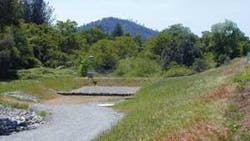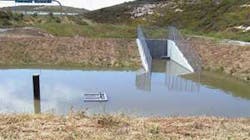By G. Scott McGowen and Anna Lantin
In the realm of stormwater quality, our public highway systems are one of the most difficult aspects of our urban environment to manage. The linear nature of our nationwide highway systems and their intense public use make pollution prevention a challenge for each of our states.
On the west coast, the California Department of Transportation (Caltrans) manages about 50,000 miles of highway and freeway lanes serving 30 million residents across a state that spans approximately 158,300 square miles. Meeting the challenges of stormwater management for this transportation network and achieving 2007 EPA Clean Water Act award-winning distinction has taken years of study, collaboration, partnerships and action. Caltrans has challenges unlike most agencies, primarily because the property maintained is linear and widespread, and has multiple crossflows requiring flexibility in accommodating best management practices (BMPs). No other permit holders within the state of California, and few within the nation, have a jurisdiction of this size and complexity. Strategies to control pollutants of concern vary due to the diversity of geographic, geologic, climatic, population, and regulatory conditions throughout the 770-mile length of the state.
Compliance with Regulations
As federal environmental regulations based on the Clean Water Act have evolved to require control of pollutants from our Municipal Separate Storm Sewer Systems (MS4s), discharges brought under the NPDES permit process have resulted in a need to find solutions to constant challenges. In California, the EPA has delegated administration of the federal NPDES program to the State Water Resources Control Board and potential location-specific activities from the nine Regional Water Quality Control Boards (RWQCBs).
Biofiltration swale located along Interstate 5 is designed to remove pollutants from roadway runoff in the coastal area of northern San Diego County, CA.
The Statewide Stormwater Management Plan (SWMP) is a requirement of the permit, which Caltrans has developed into the greatest benefit and guiding force of the program. The plan addresses stormwater and authorized non-stormwater discharges to waters of the United States as defined by U.S. EPA and waters of the state of California as defined by the Porter-
Cologne Act.
The Statewide Stormwater Management Plan
Caltrans, through this detailed SWMP and associated innovative technologies, is emerging as a recognized leader in the field, while continually seeking ways of meeting these challenges with solutions that can be applied nationwide. As the key to the program’s progress and success, the SWMP addresses the programmatic approach for achieving compliance with state and federal requirements for the protection of water quality.
The first statewide SWMP was developed and implemented in March 1997, with the current plan developed and submitted on January 15, 2004, to renew the Caltrans statewide NPDES permit. A revised, updated SWMP was submitted in June 2007.
The SWMP addresses discharges resulting from stormwater originating from precipitation and snowmelt and non-stormwater discharges including illicit and authorized discharges and emergency response activities. The California Streets and Highway Code defines “highway” to include bridges, culverts, curbs, drains and all works incidental to highway construction, improvement and maintenance. Contribution of pollutants from all of these areas is under the authority of Caltrans.
The Caltrans Stormwater Program has taken the approach of looking at the full spectrum of activities, including planning, design, construction, maintenance and operation of roadways and facilities. The Stormwater Management Plan addresses responsibilities of Caltrans for implementing stormwater management procedures and practices including training, public education, monitoring, program evaluation, BMP development and reporting activities on a statewide basis.
Caltrans BMP site located off the 241 Toll Road in Orange County, CA.
Important aspects of the program include its management and delegation of responsibility. Stewardship and management of the program begins with the six divisions dedicating staff to address stormwater issues (Environmental Engineering, Design, Construction, Maintenance, Right-of-Way and Traffic Operations/Encroachment Permits) lead by the Headquarters Division of Environmental Analysis in Sacramento. Each division is responsible for tasks related to the division’s core activities, such as developing tools, guidance and manuals, training, and administration of a Stormwater Advisory Team (SWAT). The state is divided into twelve Caltrans districts, each of which has responsibility for day-to-day, project-based implementation of the plan.
Stormwater Advisory Teams
Each division SWAT is made up of representatives from the twelve districts statewide, which come together for review of proposed and existing BMPs and process and implementation of the SWMP to gain a statewide perspective. This allows each division to evaluate the applicability and workability of the BMPs to develop practical solutions to stormwater issues. Each division develops training for its unique area. The Stormwater Advisory Teams meet independently and then come together annually in a large “Super SWAT” to discuss the issues across the state.
This results in an integrated approach to accomplishing the goals of the statewide stormwater management program and a team synergy among the functional areas and geographic regions, resulting in better communication, improved design and quality control through an informed approach on the part of all Stormwater Advisory Team members.
Additional Key Program Components
Important components of the stormwater program also include the new BMPs and the Monitoring and Discharge Characterization Program, which addresses storm drain system inventories and discharge characterization studies; BMP development, addressing the prioritization, evaluation, adoption and integration of approved design BMPs; facilities operations; public education and participation, which includes use of outreach, mass media, including the “Don’t Trash California” campaign, and public participation programs; location-specific activities and the program evaluation, which highlights field activities compliance evaluation and project design compliance evaluation; and measurable objectives, a performance-based approach and comprehensive list measuring achievement of the program activities, tasks and schedule for the program development.
Studies and BMP development information are made available to everyone within the departments through the Web to keep new information available to all members of the program.
Throughout the program, Caltrans has created new and improved program components, designed technologies and approved new BMP devices for implementation, conducted a variety of research studies on highway runoff, executed a multimillion dollar public education campaign, trained statewide personnel, garnered partnerships with other stakeholders, and participated in implementing programs with a watershed emphasis.
Developing a high-level program and participating with local and state agencies on a watershed basis has resulted in a cost-effective and well-rounded program in California to meet the challenges of stormwater management along our public highways. Caltrans has implemented and continues to enhance this unique and advanced program of stormwater quality and management that transportation agencies nationwide can use as a valuable resource.
About the Authors:
- G. Scott McGowen, P.E., is the chief environmental engineer in the Division of Environmental Analysis for Caltrans Headquarters in Sacramento, CA. He is the leader of the Stormwater Program for the state.
- Anna Lantin, P.E., is the vice president of stormwater quality with RBF Consulting in Irvine, CA. She has worked with Caltrans on its stormwater program since its inception.





